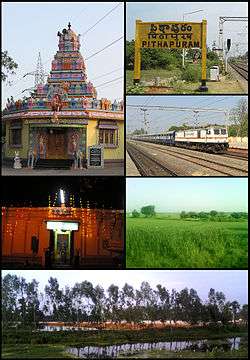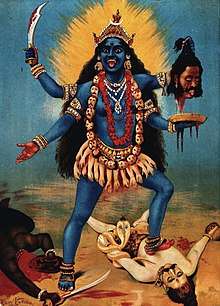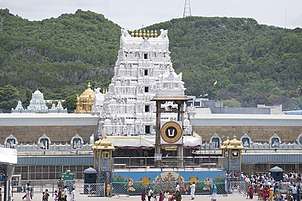Pithapuram
Pithapuram or Peetika Puram is a town and a municipality in East Godavari district in the Indian state of Andhra Pradesh. The town also forms a part of Godavari Urban Development Authority. The temple town is one of fifty five Sakti Peetikas.[4]
Pithapuram | |
|---|---|
 Clockwise from top left: Kukkuteswara and Padagaya Temple Complex, Pithapuram Railway Station, Ratnachal Express speeding through Pithapuram Railway Station, fields near Pithapuram, landscape view at Pithapuram, Kunti Madhavaswami Temple | |
.svg.png) Pithapuram Location in Andhra Pradesh, India | |
| Coordinates: 17.1167°N 82.2667°E | |
| Government | |
| • Member of Legislative Assembly | Pendem Dhorababu[1] |
| Area | |
| • Total | 41.13 km2 (15.88 sq mi) |
| Elevation | 10 m (30 ft) |
| Population (2011)[3] | |
| • Total | 52,360 |
| • Density | 1,300/km2 (3,300/sq mi) |
| Languages | |
| • Official | Telugu |
| Time zone | UTC+5:30 (IST) |
Shripada Shri Vallabha, believed to be an incarnation of Lord Dattatreya by his devotees, lived in Pithapuram.[5] He is considered one of the first complete avatars (incarnations) of the deity Dattatreya in Kali Yuga.[6]
History
Pithapuram was originally called Pishtapura. The earliest extant inscription to mention the city is the 4th century king Samudragupta's Allahabad Pillar inscription, which states that he defeated the king Mahendra of Pishtapura.[7] The inscriptions of the 4th and 5th century Vasishtha and Mathara dynasties also mention Pishtapura, describing it as a part of Kalinga.[8][7] In the 7th century, the Chalukya king Pulakeshin II annexed Pishtapura to his kingdom.[7]
The town hosts temple of Puruhitika devi. It is one among 18 shakti peethas.
Geography
Pithapuram is located at 17.1167°N 82.2667°E.[9] It has an average elevation of 10 meters (33 feet). It is located near several beaches though not one in particular. It is in between 2 major cities; Kakinada and Rajahmundry. Pithapuram is landlocked and most of its economic activity takes place in Kakinada. Pithapuram is also well known for the C.B.M. Christian Medical Centre which was started by missionary doctor Dr. E. Smith.
Demographics
As of 2011 Census of India, the town had a population of 52,360. The total population constitutes 25,891 males, 26,469 females and 5,116 children, in the age group of 0–6 years. The average literacy rate stands at 75.00% with 35,434 literates, higher than the national average of 73.00%.[3][10]
Transport
Pithapuram town is situated on NH 216. Pithapuram railway station is located on Duvvada-Vijayawada section of Howrah-Chennai main line. Rajahmundry Airport is located 55km from Pithapuram.[11]
Literature
- Kuchimanchi brothers
- Devulapalli Krishnasastry
- Avantsa somasunder
- Masilamani
- Mokkapati Narasimha Sastry
- Ryali Prasad
- Puranam subrahmanya sarma
- Umaralisha
- Balantrapu Rajanikantharao
- Venkata parvateesa kavulu
- Venkata Ramakrishna kavulu
References
- "MP, MLA participate incockfight at Pithapuram". The Hindu. 11 January 2018. Retrieved 18 August 2018.
- "Municipalities, Municipal Corporations & UDAs" (PDF). Directorate of Town and Country Planning. Government of Andhra Pradesh. Archived from the original (PDF) on 28 January 2016. Retrieved 28 January 2016.
- "Census 2011". The Registrar General & Census Commissioner, India. Retrieved 24 August 2014.
- "Constitution of Godavari Urban Development Authority with headquarters at Godavari" (PDF). Municipal Administration and Urban Development Department. Government of Andhra Pradesh. Archived from the original (PDF) on 18 January 2017. Retrieved 9 November 2016.
- http://www.sreedattavaibhavam.org/sree-pada-sree-vallabha
- http://www.sripadasrivallabhamahasamsthanam.com
- Ashvini Agrawal (1989). Rise and Fall of the Imperial Guptas. Motilal Banarsidass. p. 109. ISBN 978-81-208-0592-7.
- S. Sankaranarayanan (1977). The Vishṇukuṇḍis and Their Times: An Epigraphical Study. Agam Prakashan. p. 51.
- Falling Rain Genomics.Pithapuram
- "Chapter–3 (Literates and Literacy rate)" (PDF). Registrar General and Census Commissioner of India. Retrieved 24 August 2014.
- "Vijayawada Division – A Profile" (PDF). South Central Railway. Archived from the original (PDF) on 28 January 2016. Retrieved 19 January 2016.
| Wikimedia Commons has media related to Pithapuram. |

